Nikon D5 XQD Review
Nikon D5 XQD Introduction
The Nikon D5 XQD and Nikon D5 CF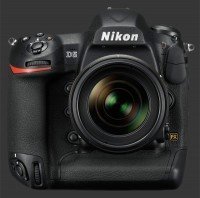
Nikon D5 CF are twin professional Full-Frame DSLRs. Launched together in early 2016, they are flagship models of the Nikon lineup. These digital cameras only differ in the type of memory cards supported, that being XQD and Compact Flash respectively. In this review, we simply refer to both as the Nikon D5.
The D5 is built around a completely new 20 megapixels Full-Frame CMOS sensor with an unprecedented sensitivity range. While the native ISO 100 to 102400 range is already quite impressive, it expands down to ISO 50 and up to ISO 3276800. This is not a typo, it really reads ISO three-point-two million! This sensor is paired with a new imaging processor as well, providing improved rendering and highly flexible image parameters.
This professional DSLR is ideal for action photography. It offers 12 FPS continuous capture with 3D Tracking autofocus using a 153-point Phase-Detect AF system. When the mirror is locked up, it can reach an even faster 14 FPS. There is deep buffer with high throughput to keep shooting for up to 200 frames, achievable by both XQD and CF models, only the former clears the buffer slightly faster.
The D5 features two shutter-releases, double dual control-dials and an integrated vertical grip. It is based on the body of the D4S reviewed here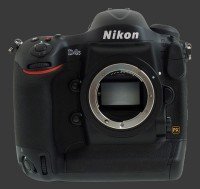
Nikon D4S, yet with a good number of refinements. Plus, video has been upgraded to 4K Ultra-HD at 30 FPS. 4K Time Lapse 4K are now also possible.
This DSLR is a powerhouse for professional photographers. It has every feature expected from its class and more like a built-in viewfinder shutter, built-in HTTP server, FTP client, wired Ethernet port and dual memory-card slots.
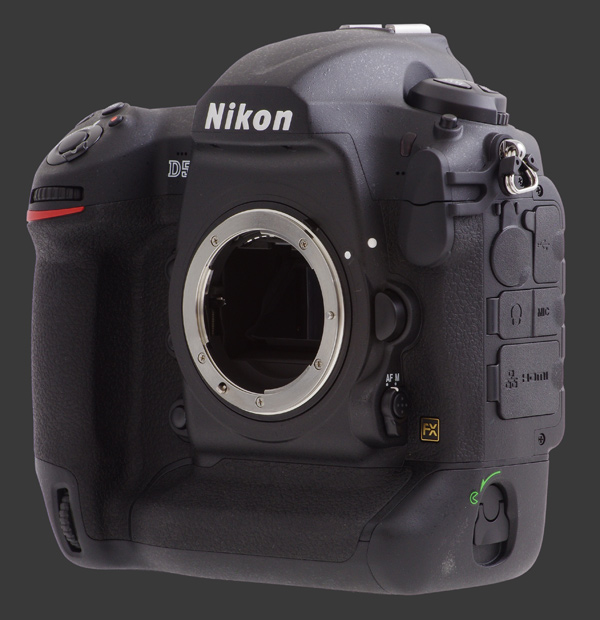
In this in-depth digital camera review, the Nikon D5 is analyzed in terms of features, usability, ergonomics, performance, image quality and controls.
Nikon D5 Features
Sensor
- 20 Megapixels CMOS sensor
- Full-Fame Nikon FX format
- Standard ISO 100 - 102,400 range
- Expanded ISO 50 - 3,276,800 range
- Customizable Auto ISO
- Built-in Dust-Reduction
- JPEG, TIFF, RAW or JPEG+RAW Output
Exposure
- PASM exposure modes
- 1/8000s - 30s Shutter-speed, plus Bulb
- EC, ±5 EV, 1/2 or 1/3 EV steps
- FC, -3...+1 EV, 1/2 or 1/3 EV steps
- Matrix, Highlight-Weighed, Center-Weighed, Average & Spot metering
- AE, Flash or AE+Flash Bracketing: 2, 3 or 5 frames, maximum 3 EV steps, 7 or 9 frames, maximum 1 EV steps
- Exposure Fine-Tuning, ±1 EV, 1/6 EV steps
- Exposure and ISO steps of 1, ½ or 1/3 EV
- HDR, 2 shots, 1-3 EV steps, 3 blending levels, single image or series
Focus & Drive
- 153-Point Phase-Detect autofocus system
- 99 cross-type points, 15 sensitive to F/8
- Autofocus sensitivity down to -4 EV
- Single-Shot and Continuous focus-drive
- AF-S: Single, Group or Auto focus-points
- AF-C: Single, Group, Dynamic Area or 3D Tracking
- Dynamic AF Area: 9, 25, 72 or 153-point
- Contrast-detect AF for Live-View and video
- Face-Detect AF in Live-View
- 12 FPS Drive, 200 JPEG or 180 RAW
- 14 FPS Drive with Mirror-Up and AF & AE locked
- Customizable Self-Timer, 1-9 Shots, 2-20s Start Delay, ½-3s Interval
- Quiet-Shutter with delayed mirror-return
- Mirror-Up and Exposure-Delay, 1-3s
- Multiple-Exposure: 2-10 shots, optional Auto Gain
- Internal-Timer: 1-9999 Times, 1-9 Shots, ½s-24h Interval, 1min-1week Start Delay
- Time-Lapse: 1s-10m interval, 1m-8h capture time
- Optional Autofocus Fine-Tuning
Images Parameters
- AutomaticThree types: Normal, Remove Warm Colors & Preserve Warm Colors, Preset, Kelvin and Custom6 Memories WB
- Preset White-Balance Fine-Tuning, 49 steps along G-M axis, 25 steps along A-B
- Kelvin White-Balance Fine-Tuning,G-M, 49 steps
- Picture Styles, 6 built-in, plus user-defined ones
- Automatic or Manual Sharpness, 37 steps
- Automatic or Manual Clarity, 41 steps
- Automatic or Manual Contrast, 25 steps
- Automatic or Manual Saturation, 7 steps
- Manually Adjustable Hue, 25 steps
- Manually Adjustable Brightness, 13 levels
- Virtual WB Bracketing, 2-9 frames, 3 steps, 2 axis
- Virtual Active D-Lighting Bracketing, 2 - 5 frames
- Optional High-ISO Noise Reduction, 3 levels
- Optional Long Shutter Noise Reduction
- Optional Distortion-Correction
- Optional Vignetting-Correction, 3 levels
- Optional Active D-Lighting (ADL), 5 levels or Auto
- Optional Dust-Off reference photo
- In-Camera RAW development
- sRGB or AdobeRGB color space
Controls
- Dual control-dials for each grip
- 8-Way joysticks for each grip
- 8-Way controller for horizontal grip
- Configurable AF-On button for each grip
- Modal drive-mode dial with generic position
- Modeless exposure-mode button
- Independent Bracketing button
- 3 Customizable Function buttons
- Customizable DOF-Preview button
- Customizable Video-Record button
- Customizable button on vertical grip
- Live-View trigger
- Focus-Point lock
Viewfinder & Displays
- 100% Coverage viewfinder, 0.72X magnification
- Built-in viewfinder shutter
- 3.2" Touchscreen LCD, 2.4 Megapixels
- Illuminated top LCD status display
- Illuminated rear LCD status display
- Illuminated controls
- Dual-Axis Digital-Level
- DOF-Preview in viewfinder
- Optional OVF composition grid
- Optional OVF overlay, 1.2X, 1.5X (DX) or 5:4
- Sound-Level monitor
Body & Construction
- Nikon F-mount
- Weather-sealed body
- Integrated vertical grip
- Hot-Shoe and Sync-Port
- Dual XQD memory slots
- Proprietary Lithium-Ion battery
- Remote Live-View over Ethernet
- GPS or wired remote connector
- Built-in HTTP server
- Built-in FTP client
- 4K Ultra-HD HDMI output
- Gigabit Ethernet port
- USB 3.0 connectivity
- Metal tripod mount
Video
- 3840x2160 @ 30 FPS 16:9 Ultra HD 4K
- 1920x1080 @ 60 FPS 16:9 HD
- Time Lapse with optional Exposure Smoothing
- Quicktime H.264 codec, 2 quality levels
- Built-in microphone, 20 levels
- Wide or Vocal Frequency Response
- Optional Wind Noise Reduction
- Optional Flicker Reduction
- Stereo Audio Input mini-jack
- Stereo Audio Output mini-jack
- Index marking
Nikon D5 XQD Capability - What can it do?
The Nikon D5 is extremely feature-rich and highly customizable. It offers every feature one would expect from a professional DSLR. In this review page, we therefore cover those features which are unique to the D5 or done differently. Even the 396-page manual does not cover all capabilities of this DSLR.
The only real omission from this DSLR is a built-in flash. Although with such an extreme ISO range and its fast continuous drive, it does not really need one. External lighting is supported though via a hot-shoe and sync-port. One thing to know for completeness is that Nikon uses lens-based stabilization and so none of their DSLR cameras have stabilization built-in. The same is true for Canon, leaving the only stabilized full-frame DSLR to Pentax, other than a few discontinued models. Note that there exists stabilized full-frame mirrorless cameras.
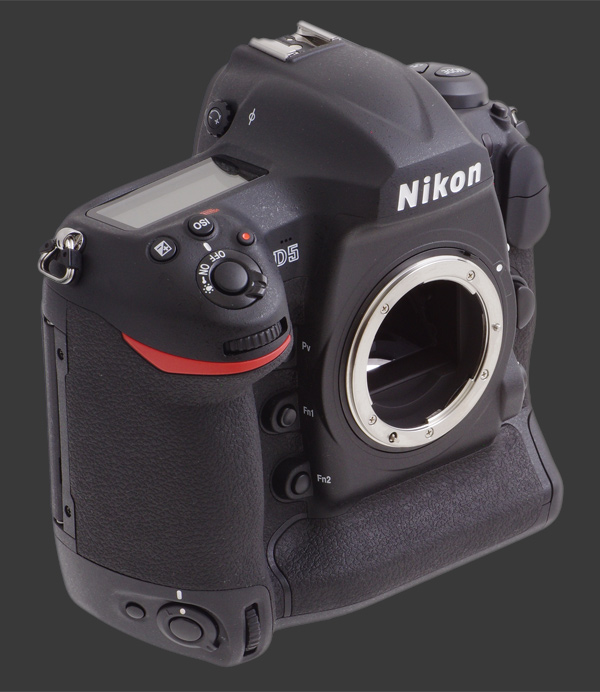
There is 3-way power-switch on the Nikon D5. Two positions are the usual On and Off choices. The third position is spring-loaded and triggers illumination of both status LCD screens plus most buttons. This is formidable for working in the dark. Optionally, they can be permanently illuminated while the camera is On. Even when the camera is off though, the status LCD nicely indicates which card is inserted and how much space is available in the first occupied slot.
This DSLR offers same extensive set of drive modes as its predecessors. There is a Continuous Low and a Continuous High position, both customizable. The Low one, CL, shoots between 1 and 10 FPS. The High one, CH, can shoot at 10, 12 or 14 FPS. At 14 FPS, the mirror stays locked up. A mechanical shutter is still used but focus and metering are unavailable and stay locked at the first frame. Most importantly though, the viewfinder stays black during the whole burst. Live View can be used, albeit with a noticeable lag.
The only unusual mode is Q which stands for Quiet Shutter. It works by moving the mirror slower than usual to reduce noise made by the camera. It also does not return the mirror to its up-position until the shutter is fully released. In practice, it barely makes a difference on the D5. The mirror sound lasts longer and has a slightly lower pitch.
As noted in the D4 review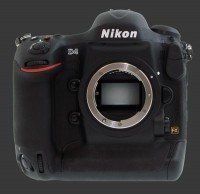
Nikon D4, there is one custom menu option which should truly be a drive mode: Exposure Delay Mode. This is effectively a 1 to 3 second self-timer which raises the mirror up at the beginning of the delay. In fact, without a remote release, this is the only way to prevent camera shake. The D5 finally makes this assignable to one of the Fn buttons, making it accessible without navigating through the menu system.
The Interval Timer is set separately from drive modes. Nikon's implementation is the most sophisticated, taking it even further than the D4S. One can specify the number of intervals and the number of shots taken at each interval. With AEB, this can be used to create an HDR time-lapse. The interval can be between ½s and 24h and number of intervals between 1 and 9999. Between 1 and 9 shots can be taken at each interval. A Start Time can be specified up to 1 week in advance now!
There is a separate Time Lapse feature which automatically creates a video from a series of frames. The interval between frames can be selected from 1s to 10m in 1s increments, while the total capture time can reach up to 8 hours. Intelligently, this DSLR warns in advance if sufficient memory is not available. Time Lapse video are rendered at the selected movie resolution and frame-rate. Crucially tough, they are framed at a 16:9 aspect-ratio.
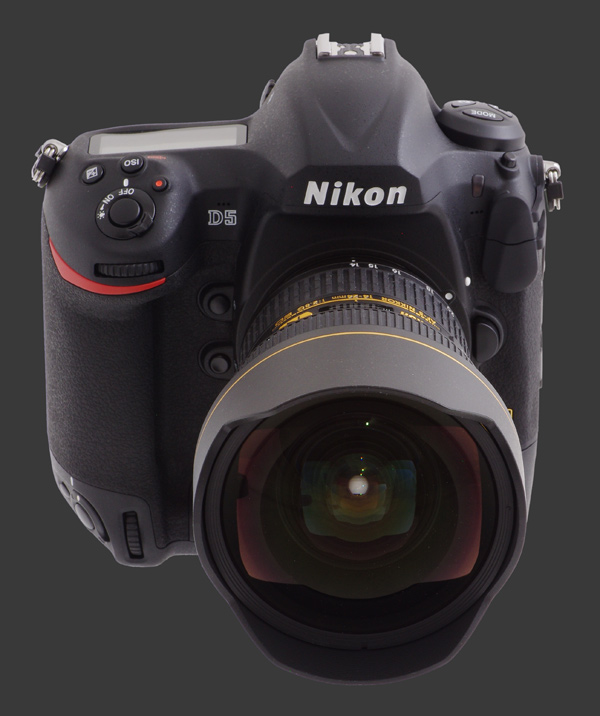
A new 153-point Phase-Detect AF system makes its debut in the Nikon D5. This is a very sophisticated system which includes 99 cross-type points and is sensitive down to a class-leading -4 EV. 15 of the cross-type points work down to F/8 which is practical when using lenses with telephoto extenders. There are a number of dynamic modes, including full 3D Tracking AF which is customizable for different subject motion and temporary obstacles. Face-Detection can even be combined with 3D Tracking.
The AF system is quite complex. To tame this, the D5 allows photographers to restrict the number of focus points and focus modes available. One can also recall different points depending on the orientation of the camera. Face-Detect AF is allowed to provide feedback to Matrix metering.
Metering patterns are chosen by a top-mounted button used with the rear control-dial. There are four choices: Matrix, Highlight Weighed, Center-Weighed/Average and Spot. Matrix is Nikon's name for Multi-Segment metering. Highlight Weighed, introduced on the Nikon D810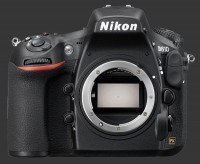
Nikon D810, provides a segmented metering system that gives priority to highlights. Spot is for Spot metering. Depending on a custom setting, the third choice activates Average or Center-Weighed metering. The same option lets the camera use one of four sizes8mm, 12mm, 15mm or 20mm for the central-portion.
Auto-Exposure Bracketing can be enabled for 2 to 9 frames with steps up to ±3 EV when taking 5 frames or less. One can bracket exposure parameters, flash or both. Virtual Bracketing for WB or Adaptive D-Lighting can be performed instead with 3 step sizes for WB and 5 for ADL. In both cases, only one photo is taken but it is rendered multiple times. For obvious reasons, Virtual Bracketing only applies to JPEG.
Standard ISO sensitivities run from 100 to 102,400. Expanded ISO values are identified by label. ISO 50 is called L 1.0. ISO 204,800 is called H 1.0 all the way to H 5.0 for 3,276,800. Full stops, half-stops or third-stops are also available. Auto ISO is unusually specified, even for a Nikon DSLR! Users configure separate maximum ISO sensitivities for normal and flash exposures, plus a minimum shutter-speed. The D5 then adjusts the chosen ISO within the permitted range to obtain at least the specified shutter-speed.
There are now three types of Automatic White-Balance. One tried renders white neutral, one makes them look natural and the last preserves warm lighting. Note that Nikon shuffled the AWB mode naming: Keep White corresponds to Normal, Normal is new and Keep Warm corresponds to the same option on the D4S.
White Balance options are quite numerous. There are 6 presets With 7 sub-types for Fluorescent: Sodium-Vapor, Warm-White, White, Cool-White, Day-White, Daylight, High Temperature Mercury Vapor.. Custom WB now has 6 memories. Each nicely shows a thumbnail of the image from which it was recorded. For measurements taken with through the OVF, the entire frame is used. For those taken via Live-View, a small selectable area can be sampled. Kelvin WB can be selected between 2500K and 10000K. WB Fine-Tuning offers two axis except for Kelvin which only supports the G-M axis. Regardless, there are always 49 steps along G-M and 25 along B-A. The numeric range along each axis is actually the same, only Nikon allows ¼-point for one and ½-point increments for the other.
This camera features Nikon's Active D-Lighting image processing technology which lightens up dark areas of images to bring out details. There are 5 levels of ADL which differ by how much shadows get boosted. ADL can be manually or automatically set to one of those levels or turned off entirely. ADL indirectly affects RAW capture because exposure is adjusted according to the selected ADL level.

The Nikon D5 features a built-in viewfinder-shutter. A simple rotating switch next to the eye-piece opens or closed it. This shutter prevents light from entering the camera through the optical viewfinder to avoid problems with long exposures. The OVF is large and relatively bright. It shows 100% full-frame coverage at 0.72X magnification. A layer of liquid crystal allows the OVF to mask a 1.2X crop, a 1.5X crop or a 5:4 aspect-ratio area.
This DSLR can capture JPEG images or RAW files, using the NEF format. The Nikon D5 can produce RAW files uncompressed, losslessly compressed or with lossy compression. Lossless compressive saves on average 40% space without any drop in quality, so this is the recommended option. All measurements here are done on losslessly compressed 14-bit per pixel RAW files. Optionally, RAW depth can be reduced to 12-bits per pixel. It saves around 20% space at the expense of 2 stops of precision.
As a professional tool designed for fast photography, the D5 includes a large number of features to improve efficiency. There are two sets of Memory Banks. One for the Shooting menu, the other for the Settings menu. Each has 4 memories which can be selected independently. The only thing not stored are functions that involve multiple images such as Multiple Exposure and Interval Timer. A Voice Memo function lets the photographer annotate images after taking them. This is valuable for all sorts of reasons, like remember why a photo was taken or what circumstances surround it. Voice memos are saved as separate WAV files.
Connectivity is an important part of a professional workflow. As such, the Nikon D5 features a full-size USB 3.0 and Gigabit Ethernet port. There is a terminal for a Nikon 10-pin remote plus another prioprietary port for a WiFi or GPS module. It also has a mini HDMI port that outputs at 4K. Two mini jacks allow stereo sound input and output for video use.
 |
Please Support Neocamera
All information on Neocamera is provided free of charge yet running this website is a huge endeavor. Purchases made via affiliate links found throughout the site help keep it running and up-to-date. There is no additional cost to you, so please consider buying via these links to our affilates:
If you found any information on this site valuable and did not purchase via our affiliate links, please considering donating via PayPal:
Any amount will be greatly appreaciated. Thank you for your support!
Nikon D5 XQD Highlights

Sensor-Size: 36 x 24mm

Actual size when viewed at 100 DPI
| 20 Megapixels DSLR | ISO 100-3280000 |
| Nikon F Mount 1X FLM | Shutter 1/8000-30s |
| 100% Coverage Extra Large Viewfinder | Full manual controls, including Manual Focus |
| 2 Axis Digital Level | Custom white-balance with 2 axis fine-tuning |
| Weatherproof | Spot-Metering |
| Built-in Dust Reduction | Hot-Shoe & Sync-Port |
| 12 FPS Drive, 200 Images | Stereo audio input |
| 3840x2160 @ 30 FPS Video Recording | Lithium-Ion Battery |
| 3.2" LCD 2.4 Megapixels | XQD x 2 CF Express Type B x 2 |
Updates
2025.01.18

Fujifilm GFX 2025 Lens Roundup
Lens Review roundup of Fujifilm GFX Medium-Format lenses. Quality, performance and handling of the GF20-35mm F/4R WR, GF30mm F/3.5 Tilt-Shift and the GF55mm F/1.7.
2024.11.18

Best 2024 Photography Gifts for Every Budget
Great gifts for photographers and photo enthusiasts selected for every budget among the best products of 2024.
2024.08.07

Eye Protection Tips for Professional Photographers
The four main considerations for professional photographers regarding eyewear.
2024.07.14

Fujifilm X100VI Review
Flagship fixed-lens compact digital camera with a 40 MP sensor and Image-Stabilization, a first for the series. Retro design featuring dual control-dials, plus direct ISO, Shutter-Speed and EC dials. Its hybrid viewfinder can switch between EVF and OVF mode.
2024.05.09

Fujifilm GFX100 II Review
Flagship 102 Megapixels Medium-Format Mirrorless Digital Camera with 8-Stop 5-Axis IBIS, 8 FPS Drive, 8K Video and 400 MP Super-Resolution capture in a weatherproof and freezeproof body with dual control-dials and dual memory-card slots.
2024.04.03

Fujifilm X-T5 Review
Newest Fujifilm flagship boasting a 40 MP APS-C sensor, 5-axis IBIS with 7-stop efficiency, 15 FPS continuous drive, 6.2K Video capture, dual control-dials and dual SDXC UHS-II slots in a sturdy weatherproof and freezeproof body.
2023.11.20

Best Digital Cameras of 2023
Find out which are the Best Digital Cameras of 2023. All the new Mirrorless Digital Cameras from entry-level to high-end professional.
2023.07.10

Fujifilm X-H2 Review
40 Megapixels APS-C Hybrid Mirrorless Digital Camera with 7-stop IBIS. Fastest shutter ever and 8K video capture. Large builtin EVF with 0.8X magnification and 5.8 MP, plus an Eye-Start Sensor. Packed with features and large number of controls in a weatherproof and freezeproof body.
2023.05.07

Sony FE 20-70mm F/4G Review
Review of the unique Sony FE 20-70mm F/4G lens. The optical zoom of this lens spans ultra-wide-angle and medium focal-length coverage, making it one of the most versatile Full-Frame lenses on the market.
2023.01.15

Huion Inspiroy Dial 2 Review
Review of the Huion Inspiroy Dial 2 tablet, a medium sized drawing surface with dual dials and customizable buttons. Connects via USB-C or Bluetooth 5.0 with Windows, Linux and Android support.
2022.12.08

How to Pack for a Photo Trip
Find out how to pack for a travel photography trip, carry your gear safely while meeting airline regulations.
2022.11.13

Best Digital Cameras of 2022
The best digital cameras of 2022. A short list of the most outstanding models in their respective categories. Choose one for yourself or as a gift.













